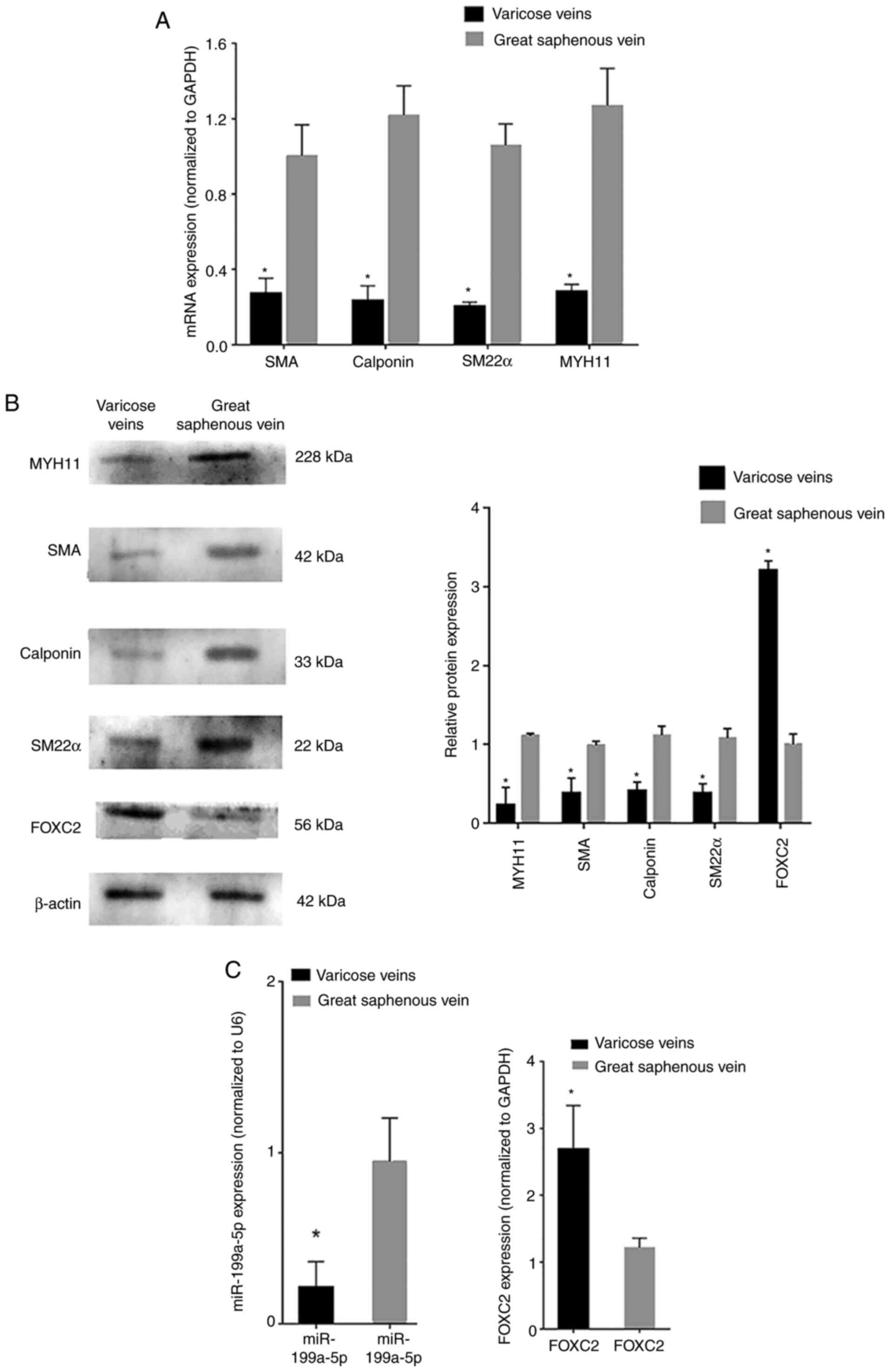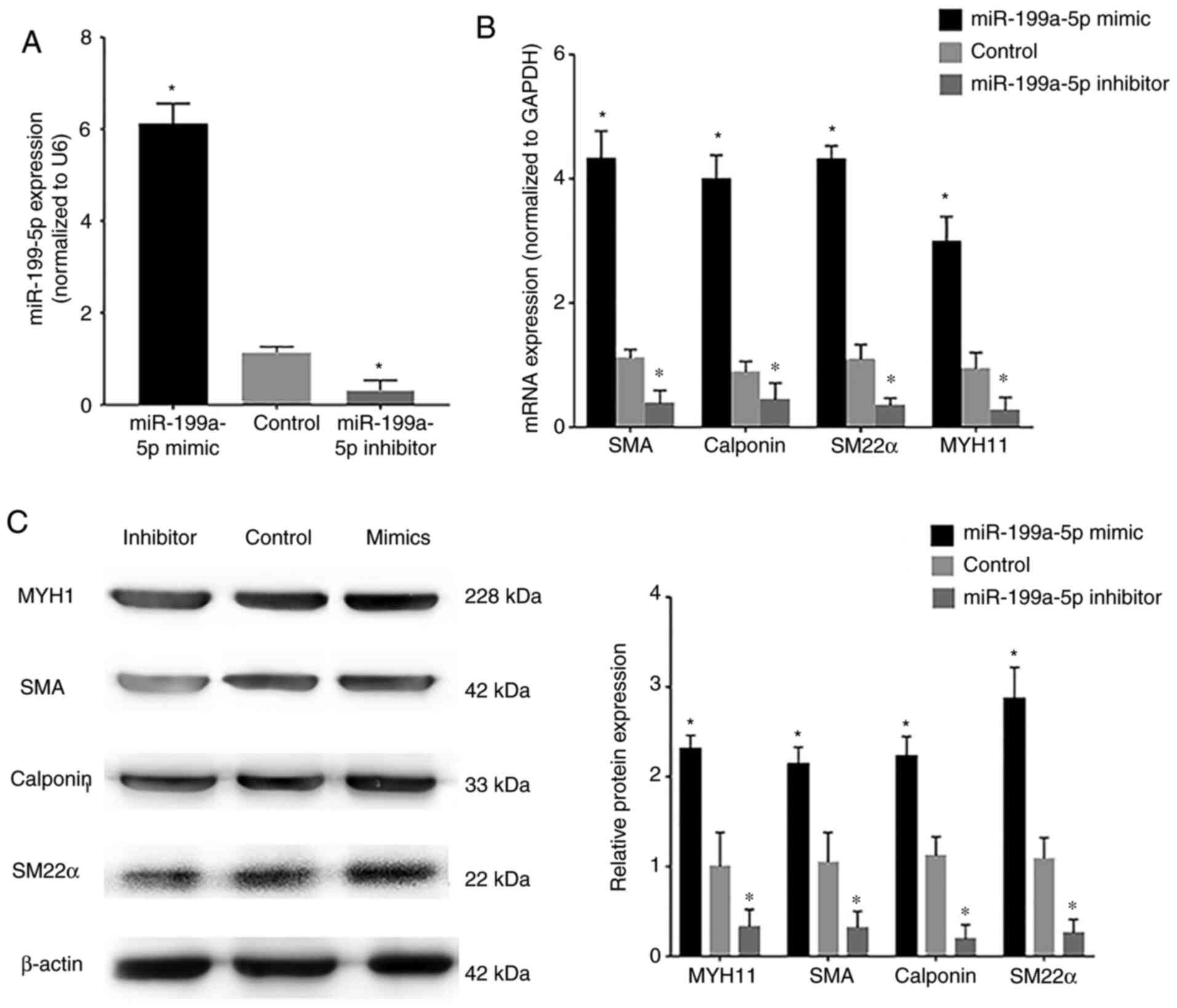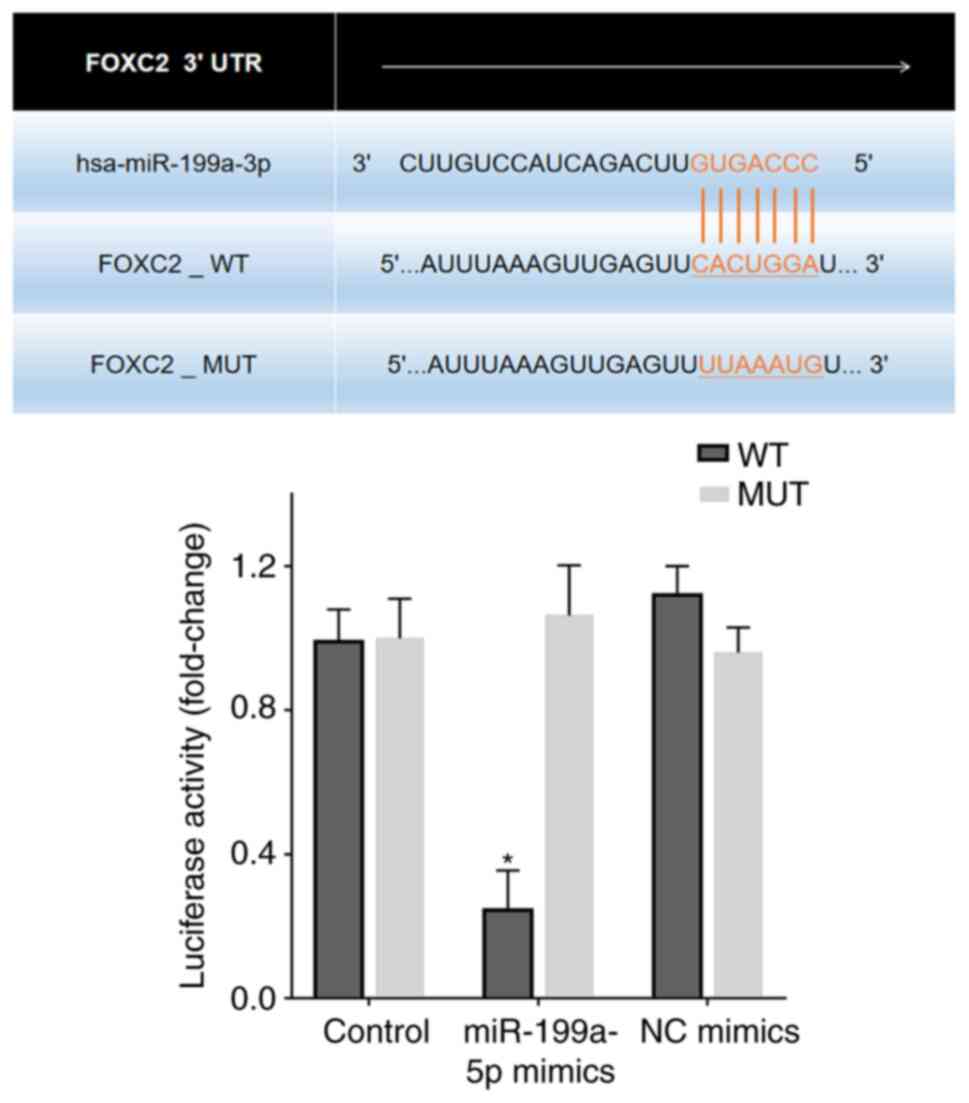|
1
|
Piazza G: Varicose veins. Circulation.
130:582–587. 2014. View Article : Google Scholar : PubMed/NCBI
|
|
2
|
Jacobs BN, Andraska EA, Obi AT and
Wakefield TW: Pathophysiology of varicose veins. J Vasc Surg Venous
Lymphat Disord. 5:460–467. 2017. View Article : Google Scholar : PubMed/NCBI
|
|
3
|
Xu Y, Bei Y, Li Y and Chu H: Phenotypic
and functional transformation in smooth muscle cells derived from
varicose veins. J Vasc Surg Venous Lymphat Disord. 5:723–733. 2017.
View Article : Google Scholar : PubMed/NCBI
|
|
4
|
Huang X, Liu Z, Shen L, Jin Y, Xu G, Zhang
Z, Fang C, Guan W and Liu C: Augmentation of miR-202 in varicose
veins modulates phenotypic transition of vascular smooth muscle
cells by targeting proliferator-activated receptor-γ
coactivator-1α. J Cell Biochem. 120:10031–10042. 2019. View Article : Google Scholar : PubMed/NCBI
|
|
5
|
Qi XB, Jia B, Wang W, Xu GH, Guo JC, Li X
and Liu JN: Role of miR-199a-5p in osteoblast differentiation by
targeting TET2. Gene. 726:1441932020. View Article : Google Scholar : PubMed/NCBI
|
|
6
|
Bao N, Fang B, Lv H, Jiang Y, Chen F, Wang
Z and Ma H: Upregulation of miR-199a-5p protects spinal cord
against ischemia/reperfusion-induced injury via downregulation of
ECE1 in rat. Cell Mol Neurobiol. 38:1293–1303. 2018. View Article : Google Scholar : PubMed/NCBI
|
|
7
|
Zhu H: Forkhead box transcription factors
in embryonic heart development and congenital heart disease. Life
Sci. 144:194–201. 2016. View Article : Google Scholar : PubMed/NCBI
|
|
8
|
Liu Y, Liu G, Zhang H and Wang J:
MiRNA-199a-5p influences pulmonary artery hypertension via
downregulating Smad3. Biochem Biophys Res Commun. 473:859–866.
2016. View Article : Google Scholar : PubMed/NCBI
|
|
9
|
Huang Y, Zhang S, Fang X, Qin L, Fan Y,
Ding D, Liu X and Xie M: Plasma miR-199a-5p is increased in
neutrophilic phenotype asthma patients and negatively correlated
with pulmonary function. PLoS One. 13:e01935022018. View Article : Google Scholar : PubMed/NCBI
|
|
10
|
Agarwal V, Bell GW, Nam JW and Bartel DP:
Predicting effective microRNA target sites in mammalian mRNAs.
Elife. 4:e050052015. View Article : Google Scholar : PubMed/NCBI
|
|
11
|
Mellor RH, Brice G, Stanton AW, French J,
Smith A, Jeffery S, Levick JR, Burnand KG and Mortimer PS;
Lymphoedema Research Consortium, : Mutations in FOXC2 are strongly
associated with primary valve failure in veins of the lower limb.
Circulation. 115:1912–1920. 2007. View Article : Google Scholar : PubMed/NCBI
|
|
12
|
Guo Z, Luo C, Zhu T, Li L and Zhang W:
Elevated c-fos expression is correlated with phenotypic switching
of human vascular smooth muscle cells derived from lower limb
venous varicosities. J Vasc Surg Venous Lymphat Disord. 9:242–251.
2021. View Article : Google Scholar : PubMed/NCBI
|
|
13
|
Surendran S, Ramegowda KS, Suresh A, Binil
Raj SS, Lakkappa RK, Kamalapurkar G, Radhakrishnan N and C Kartha
C: Arterialization and anomalous vein wall remodeling in varicose
veins is associated with upregulated FoxC2-Dll4 pathway. Lab
Invest. 96:399–408. 2016. View Article : Google Scholar : PubMed/NCBI
|
|
14
|
Baeten JT and Lilly B: Notch signaling in
vascular smooth muscle cells. Adv Pharmacol. 78:351–382. 2017.
View Article : Google Scholar : PubMed/NCBI
|
|
15
|
Porter JM and Moneta GL: Reporting
standards in venous disease: An update. International Consensus
Committee on Chronic Venous Disease. J Vasc Surg. 21:635–645. 1995.
View Article : Google Scholar : PubMed/NCBI
|
|
16
|
Livak KJ and Schmittgen TD: Analysis of
relative gene expression data using real-time quantitative PCR and
the 2(-Delta Delta C(T)) method. Methods. 25:402–408. 2001.
View Article : Google Scholar : PubMed/NCBI
|
|
17
|
Tang Y, Yu S, Liu Y, Zhang J, Han L and Xu
Z: MicroRNA-124 controls human vascular smooth muscle cell
phenotypic switch via Sp1. Am J Physiol Heart Circ Physiol.
313:H641–H649. 2017. View Article : Google Scholar : PubMed/NCBI
|
|
18
|
Ahmadi A, Khansarinejad B, Hosseinkhani S,
Ghanei M and Mowla SJ: miR-199a-5p and miR-495 target GRP78 within
UPR pathway of lung cancer. Gene. 620:15–22. 2017. View Article : Google Scholar : PubMed/NCBI
|
|
19
|
Ma S, Jia W and Ni S: miR-199a-5p inhibits
the progression of papillary thyroid carcinoma by targeting SNAI1.
Biochem Biophys Res Commun. 497:181–186. 2018. View Article : Google Scholar : PubMed/NCBI
|
|
20
|
Zhu QD, Zhou QQ, Dong L, Huang Z, Wu F and
Deng X: MiR-199a-5p inhibits the growth and metastasis of
colorectal cancer cells by targeting ROCK1. Technol Cancer Res
Treat. 17:15330346187755092018. View Article : Google Scholar : PubMed/NCBI
|
|
21
|
Qu D, Yang Y and Huang X: miR-199a-5p
promotes proliferation and metastasis and epithelial-mesenchymal
transition through targeting PIAS3 in cervical carcinoma. J Cell
Biochem. 120:13562–13572. 2019. View Article : Google Scholar : PubMed/NCBI
|
|
22
|
Lim CS and Davies AH: Pathogenesis of
primary varicose veins. Br J Surg. 96:1231–1242. 2009. View Article : Google Scholar : PubMed/NCBI
|
|
23
|
Pham TND, Perez White BE, Zhao H,
Mortazavi F and Tonetti DA: Protein kinase C α enhances migration
of breast cancer cells through FOXC2-mediated repression of
p120-catenin. BMC Cancer. 17:8322017. View Article : Google Scholar : PubMed/NCBI
|
|
24
|
Ren YH, Liu KJ, Wang M, Yu YN, Yang K,
Chen Q, Yu B, Wang W, Li QW, Wang J, et al: De-SUMOylation of FOXC2
by SENP3 promotes the epithelial-mesenchymal transition in gastric
cancer cells. Oncotarget. 5:7093–7104. 2014. View Article : Google Scholar : PubMed/NCBI
|
|
25
|
Zheng CH, Quan Y, Li YY, Deng WG, Shao WJ
and Fu Y: Expression of transcription factor FOXC2 in cervical
cancer and effects of silencing on cervical cancer cell
proliferation. Asian Pac J Cancer Prev. 15:1589–1595. 2014.
View Article : Google Scholar : PubMed/NCBI
|
|
26
|
Liu B, Han SM, Tang XY, Han L and Li CZ:
Overexpressed FOXC2 in ovarian cancer enhances the
epithelial-to-mesenchymal transition and invasion of ovarian cancer
cells. Oncol Rep. 31:2545–2554. 2014. View Article : Google Scholar : PubMed/NCBI
|
|
27
|
Wu X and Liu NF: FOXC2 transcription
factor: A novel regulator of lymphangiogenesis. Lymphology.
44:35–41. 2011.PubMed/NCBI
|
|
28
|
Sano H, Leboeuf JP, Novitskiy SV, Seo S,
Zaja-Milatovic S, Dikov MM and Kume T: The Foxc2 transcription
factor regulates tumor angiogenesis. Biochem Biophys Res Commun.
392:201–206. 2010. View Article : Google Scholar : PubMed/NCBI
|
|
29
|
Zhang C, Li H and Guo X: FOXC2-AS1
regulates phenotypic transition, proliferation and migration of
human great saphenous vein smooth muscle cells. Biol Res.
52:592019. View Article : Google Scholar : PubMed/NCBI
|
















